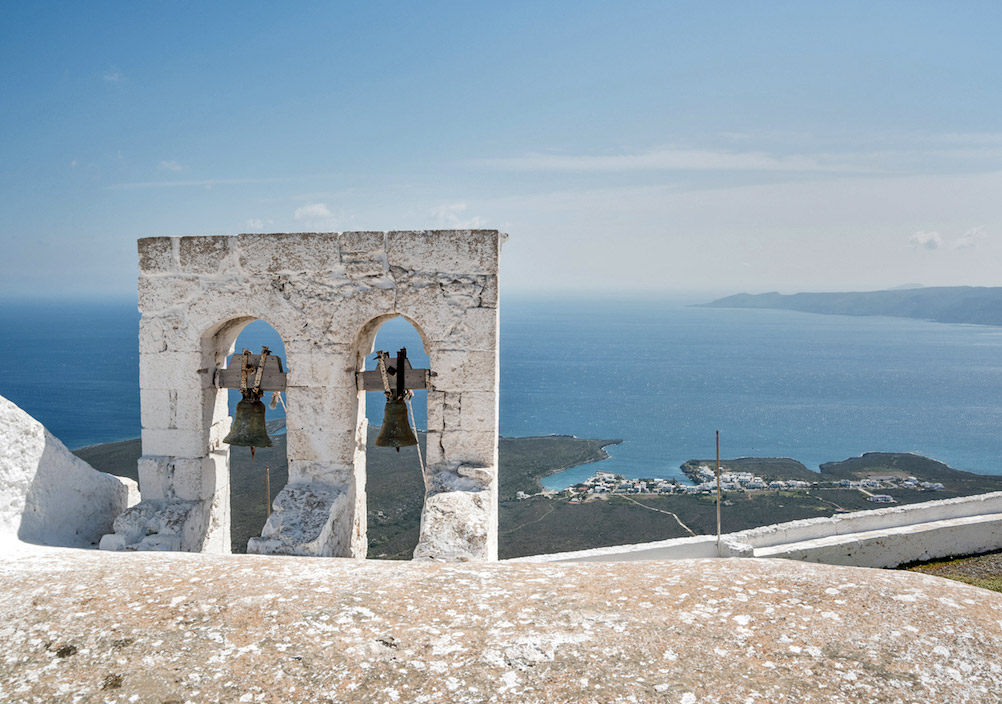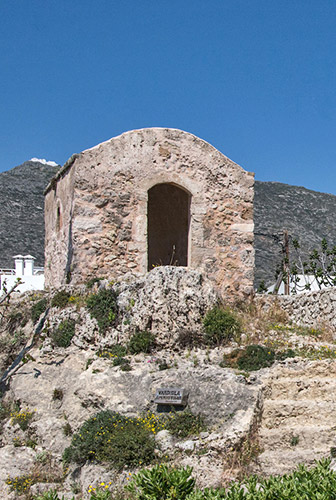Mythology
Hesiod in Theogonia (750-700 BC) reports that Earth being resentful with her husband Uranus asked Kronos to help her in order not to have his own children again. Kronos cut his father’s genitals and threw them into the sea from the foam of which Aphrodite was born. The goddess first ascended in Palaeopoli before being transferred to Paphos, Cyprus, into a huge shell.
This myth refers to the big geological agitations that happened on the island of Kythera, which emerged from the sea, as it appears from the regions which once were sea bottom and now they are full of shells.
The Palaeopoli beach is full of heart-shaped pebbles, proof that Aphrodite, goddess of love, was born in the area. In the nearby beach of Limni, it is also believed that, under the protection of Aphrodite, Paris and Beautiful Helen found refuge before they sailed to Troy.
In addition, lovers who wanted to tighten their marital bonds came to Kythera for this reason. Due to the old age of the sanctuary on Kythera the goddess was worshipped as the Celestial Aphrodite, Goddess of ideal platonic love, and not as Pandemos Aphrodite, who was worshipped later during the classical era when she became the protector of free and commercial love affairs. Plato makes this distinction. We can imagine the couples who wanted to intensify their marital ties to be bathing in Palaeopoli and then coming as pious pilgrims to the temple of the goddess.
Prehistoric / Minoan / Mycenaean period
The archaeological evidence (pottery fragments, stone tools) from Palaeopoli and other parts of the island suggest that Kythera was first inhabited in the fifth millennium BC.
The archaeological excavations in ancient Skandia (Palaeopoli) showed that the first Minoan settlers arrived at around 2500 BC. The Minoans predicted the advantage of the region in strengthening their commercial activities and therefore used this part of the island as a trading post (Skandia).
The Minoan colony was complemented with the peak sanctuary on the mountain of Aghios Georgios (Saint George). The excavations that took place there unearthed votive bronze statuettes, ceramics and stone utensils used for religious purposes. Objects from excavations in Skandia and the mountain of Aghios Georgios can be admired in the Archaeological Museum of Chora. In addition, one can ascend the mountain of Aghios Georgios through a marked trail that starts from Avlemonas.
Moreover, on a small hill positioned in the middle of the long beach of Palaeopoli, in Asprogas, there are rock-cut chamber tombs, which date roughly between 1700-1500 BC. In the cemetery grounds there is also a Cenotaph situated on the edge of the hill known by the locals as the throne of Aphrodite. ‘’The Baths of Aphrodite’’ is said to be the partition between the Palaeopoli beach and the Limni beach, beneath the walls of Ancient Skandia.
Skandia is mentioned by Homer, like Thucydides, as the main port of Kythera. Strabo reports that it was a good harbour and hosted shipyards. At various points of the plain of Palaeopoli there are limestone boulders which were part of the waterfront that was 500 meters long and 200 meters wide.
One of the main occupations of the inhabitants of the area was the fishing of the purple dye murex (Porfyra). Entire fishing crews were engaged in fishing this type of shell. From these shells a purple dye was extracted with which the cloaks of Kings and officials were painted and this dye was generally sought after and expensive.
In addition, in the Small Dragonara (an islet off Avlemonas) the remains of the Poseidon Geiochou sanctuary have been found. It was he who held the reins of the earth and caused earthquakes. Archaeologists have found votive pottery of the Hellenistic period, stone rings, coins (250 in number) from 54 different cities and kingdoms of the Mediterranean and the Black Sea. The findings show that the navigators of the time were willing to offer something to the god Poseidon to appease the sea, so that they could travel safely. The sanctuary operated from the late 4th century to the Roman period. There are objects from the excavations in the Archaeological Museum of Kythera. The Small and Big Dragonara can be seen from the trail, with the stunning view, which starts from Avlemonas and reaches Diakofti.
The entire area between Avlemonas and Palaeopoli and the road leading from Diakofti to Palaeopoli is scattered with ancient sandstone quarries where one can clearly see the marks of the tools used to extract these stones. These quarries were used from the prehistoric period up to the modern times.
Roman / Byzantine period
The Kastri or Kastraki area of Palaeopoli owes its name to the Roman / Byzantine fortifications of the 6th century AD that were destroyed for the most part by the great earthquake in 1798.
The church of Aghios Georgios (Saint George) on the mountain was rebuilt after the 12th century on the foundations of an older Byzantine church, since the preserved mosaic floor, which depicts a hunting scene, is from the 7th century AD. At the eastern edge of the mountain there is a Watchtower which was used for communication. Through lighting fires the guards sent messages to other parts of the island for approaching enemy ships.
In Palaeopoli, on the right bed of the dried river, towards Mitata and 1 km within the ravine, we find the church of Saint Panteleimon. The sanctuary of the temple is from the 7th century AD.
Venetian occupation
Since the 13th century Kythera was under the Venetian rule. At the hill opposite the little harbour of Avlemonas, there are the remains of the octagonal Venetian fortress with the lion of Saint Mark at the entrance. The fort was built in 1565 to protect the harbour. Some cannons and rooms of the castle have been preserved. It has cannon-ports, a central tower, warehouses, rooms for the guards and some abandoned cannons. The permanent garrison was 5 men strong.
The port of Aghios Nikolaos (Saint Nicolas) at the end of the village was the main port of Kythera during the Venetian and British occupation. In the port of Agios Nikolaos there is also the “Vardiola”, a watchtower which resembles a little church. The Venetians used it to communicate with the various parts of the island where there were also other similar watchtowers (e.g. at the top of Aghios Georgios).
Also, in the same part of the village there is the historic house of Cavallini. It has a sundial (solar clock), the only one that has been saved intact on Kythera. This building served as the consulate of Austrian-Hungarian empire, during the 19th century, and was later used as a customs office and even as a cafe.
Recent period
Within the stone yards of Avlemonas and Palaeopoli the inhabitants cultivated olive trees, vines, fig trees and cereals during the 19th and 20th centuries. These stone yards were mainly built in the past 3-4 centuries without ruling out the possibility of some going back even to the Byzantine or Classical times. As a general guide, the perpendicular stone yards are older than the cyclical ones. The latter were built mostly during the 19th and 20th centuries.
Outside the port of Avlemonas there is the shipwreck of “Mentor”, the ship of Lord Elgin, which sunk on September 5, 1802. It carried sculptures from the decoration of the Parthenon and the temple of Athena Nike. The ship was anchored off the port of Avlemonas to be protected from the bad weather but the two anchors unhooked from the seabed and the ship fell on the rocks and sunk. The hull lies at a depth of 22 meters.
The entire load with the marbles was dragged up from the bottom of the sea by sponge divers from Kalymnos in the span of two years. So far, since 2009 that the underwater excavation of the hull began, the archaeologists have pulled out various objects of the crew and equipment from the vessel (chandeliers, candlesticks), navigation instruments and ancient coins.
The Avlemonas/Palaeopoli region is an important attraction for many tourists because of its natural beauty and its archaeological and mythological interest, while Kytherians themselves consider the village of Avlemonas as perhaps the most beautiful village of the island and one of the prettiest sea villages in the Mediterranean.






